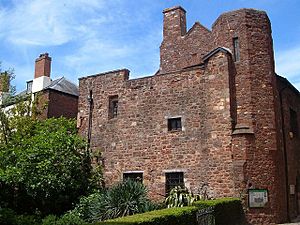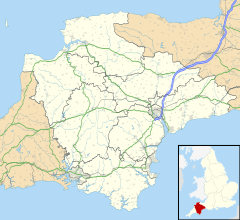St Nicholas' Priory, Exeter facts for kids
Quick facts for kids Benedictine Priory of St Nicholas |
|
|---|---|

St Nicholas Priory, Exeter
|
|
| Religion | |
| Affiliation | Roman Catholic |
| Ecclesiastical or organizational status | events venue |
| Status | events and private hire |
| Location | |
| Location | Exeter, England |
| Architecture | |
| Architectural type | Priory |
| Completed | 1087 |
The Benedictine Priory of St Nicholas, often called St Nicholas Priory, was a special kind of monastery in Exeter, England. It was built by Benedictine monks way back in 1087.
During a time called the Dissolution of the Monasteries, the priory's church and meeting hall were taken down. However, the buildings where the monks lived were kept safe. Today, some parts of the old monastery still stand. The western part is now a museum, looked after by the Exeter Historic Buildings Trust.
Contents
Discovering St Nicholas Priory's Past
How the Priory Began
In 1068, William the Conqueror attacked Exeter. This was because the mother of Harold Godwinson, a king William had just beaten, was living there. After she quickly left, William gave the church of St Olave in Exeter to Battle Abbey.
Monks from Battle Abbey came to manage the church and its lands. They started building their own monastery, which was finished in 1087. They named it after Saint Nicholas.
Growing and Helping Others
During the 1100s and 1200s, the Priory received many gifts of land and property. With this money, they built new parts of the monastery. Monasteries were known for their hospitality, meaning they welcomed visitors.
The monks had a special guest house. They offered a place to stay for pilgrims and other travelers. Important guests also found accommodation there.
Changes Through the Centuries
The Priory was a very important and busy place in Exeter for many years. But in 1536, King Henry VIII decided to close many smaller monasteries. The monks were given pensions, and their church and cloisters (covered walkways) were pulled down. Some of the stones were even used to fix the nearby Exe Bridge.
The remaining buildings and land were then sold by the King. Between 1575 and 1602, the Priory was turned into a grand Elizabethan house. Later, it was divided into smaller homes and businesses. From 1820 to 1913, it became five separate properties, each with its own doors and windows.
Exeter Corporation bought the Priory in 1913. They wanted to restore it to show its original monastic style. It opened to the public as a small museum three years later, in 1916.
Restoring the Priory's Beauty
In 2007, the Priory underwent major repairs and updates. Funding came from the HLF and Renaissance projects. During this time, parts of the Priory were restored to look like a wealthy Tudor merchant's house from 500 years ago. The restoration used building methods from that same period.
In early 2009, more maintenance work was done by a company called Sub-Lime Renovations. Today, the Priory is recognized as a Grade I listed building by Historic England. This means it's a very important historical site.
From Museum to Exciting Events Venue
A Glimpse into Tudor Life
From 1916, St Nicholas Priory served as a museum. It was set up to look like an Elizabethan town house from 1602. This was the home of the rich Hurst family.
Inside, you could see replica furniture and bright colors, just like in the Elizabethan period. It offered a look into Tudor life, using items from Exeter's own collections. The museum also had modern facilities like toilets and a gift shop.
A New Chapter for the Priory
The Priory had to close from 2015 to 2018 because of structural problems. But it reopened under the Exeter Historic Buildings Trust. Now, it's a popular place for events and private parties.
You can explore the Priory for free every Sunday from 1:00 PM to 4:00 PM. This is available from February to November each year. It also hosts many exciting events throughout the year.
See also
- Exeter Blackfriars
- Exeter Cathedral
- Exeter Greyfriars
- Exeter monastery
- Polsloe Priory
- St James Priory, Exeter


